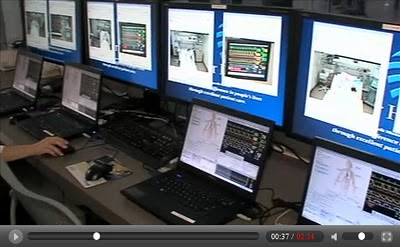Medical training simulators are rapidly becoming one of the most effective and popular uses of simulation-based training software. Medical training simulations can improve the bottom line by providing safe and relatively inexpensive training across many different medical specialties. In addition to providing new training for existing surgical procedures, medical training simulators are critical when it comes to training surgeons for robot-assisted surgeries which are becoming more common every day. Everyone benefits from medical training simulators, including medical and surgical equipment manufacturers, hospital administrators and surgeons, and even patients.

Simulated Surgical Systems provides a Robotic Surgical Simulator (ROSS) that is used to familiarize and train surgeons on the da Vinci robotic-assisted surgery system, practicing everything from cutting tissue and sewing incisions, to complete surgical procedures. The ROSS is divided into three levels:
- Motor skills: teaches surgeons the hand-eye coordination skills necessary to work with the robot.
- Clinical applications: teaches surgeons how to perform the specific elements of surgical procedures.
- Procedures: surgeons must perform virtual hysterectomies and prostatectomy, the 2 most commonly preformed robotic surgery procedures.
Medical simulations are becoming so popular that Banner Health has just established the Banner Simulation Medical Center, a virtual hospital used to train physicians and nurses before they ever treat actual patients.

The Banner Simulation Medical Center, located in Mesa, Arizona, is a 55,000 square foot facility capable of training more than 1,800 medical personnel on patient care situations common to intensive care units, emergency rooms, and operating rooms (including virtual surgery simulators).

Click to watch the Banner Medical Center Grand Opening Video
Health and Hospitals and the City of New York have also started construction on a medical simulation center that will be New York City’s largest and most advanced medical training technology center. This $10 million, 10,000 square foot facility located on the Jacobi Medical Center campus in the Bronx, will simulate emergency room, operating room, and other patient care settings to help train health care professionals to master medical procedures. Expected to be completed by the fall of 2010, the simulation center will be able to train 14,000 medical professionals in it’s first 3 years of operation.
Medical training simulators are revolutionizing medicine, changing the age-old approaches to training and teaching, and challenging the status quo. Taking advantage of the latest technology allows forward-thinking companies and hospitals to stay ahead of their competitors by providing the highest level of medical training, in a virtual environment where the worst-case scenario is a reboot, and not the loss of an actual patient.
Hospitals have found that the use of medical training simulations can reduce the amount of surgical errors, create time savings in both procedural and instructional settings, provide a reduction in real-world equipment repair costs (due to less trainee access), as well as provide a revenue stream by selling training time on the simulator. Medical training simulators allow for enhanced recruiting, better trainee evaluation, and a higher overall quality of care.
